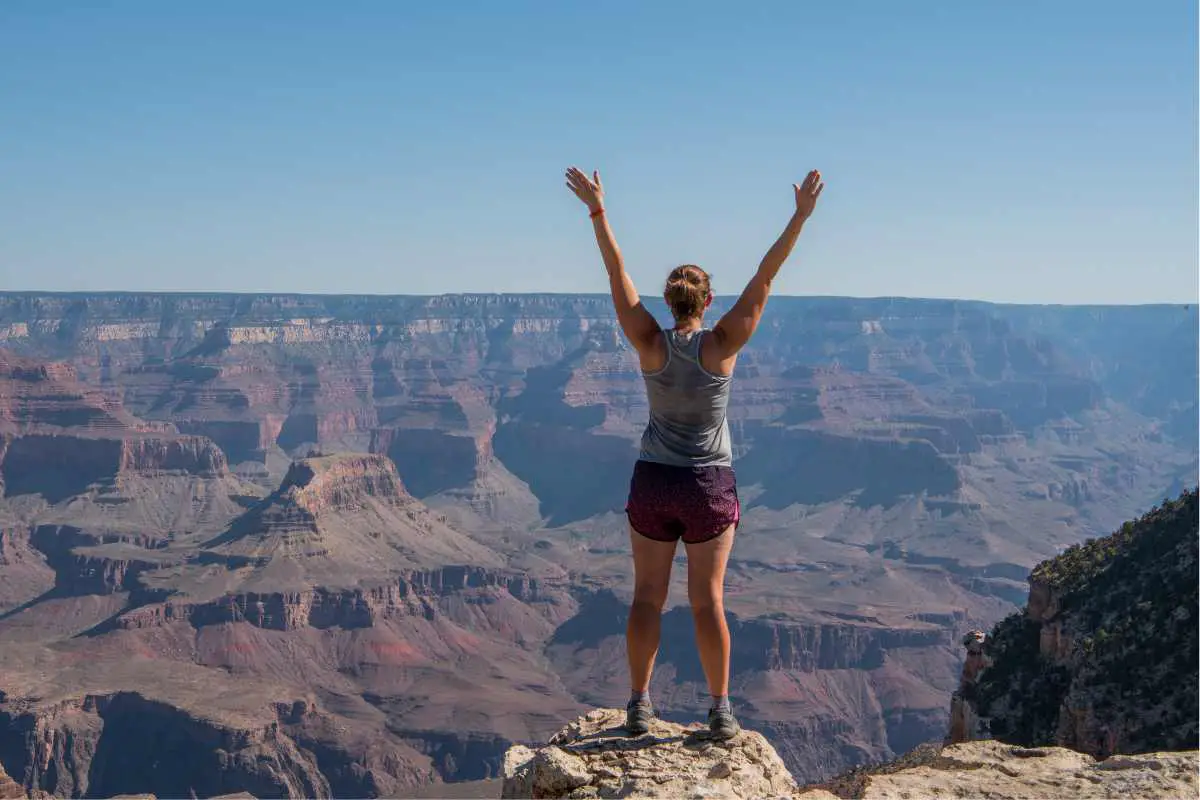Hiking rim to rim in the Grand Canyon is a bucket-list adventure that attracts outdoor enthusiasts from around the world.
This iconic trail offers breathtaking views of the canyon, challenging terrain, and a true sense of accomplishment for those who complete it. The rim-to-rim hike can be done in either direction, from the North Rim to the South Rim or vice versa, and requires careful planning and preparation.
The Grand Canyon is one of the most awe-inspiring natural wonders in the world, and hiking rim to rim is one of the best ways to experience its beauty up close.
The trail covers nearly 24 miles and descends below the rim, crosses the mighty Colorado River, and climbs back up the other side. The hike is challenging and requires a good level of physical fitness, but the rewards are well worth the effort.
Whether you’re an experienced hiker or a novice, hiking rim to rim in the Grand Canyon is an adventure of a lifetime. In this article, we will provide a comprehensive guide to planning and executing the rim-to-rim hike, including the best time to go, the recommended route, and tips from experts.
We’ll also cover the logistics of the hike, including permits, gear, and training, to help you prepare for this unforgettable experience.
Understanding the Grand Canyon Rim-to-Rim Hike

Hiking the Grand Canyon Rim-to-Rim is a challenging and rewarding experience that requires careful planning and preparation.
The hike involves descending one rim of the canyon, crossing the Colorado River, and ascending the other rim.
The two most popular routes for the hike are:
- the North Kaibab Trail on the North Rim
- and the Bright Angel Trail on the South Rim
The Grand Canyon Rim-to-Rim hike is an extremely strenuous activity that requires a high level of fitness, endurance, and mental toughness.
The hike covers a distance of approximately 24 miles and involves a total elevation change of over 10,000 feet. Hikers should be prepared for extreme temperatures, rugged terrain, and unpredictable weather conditions.
The North Kaibab Trail is the primary route for hikers starting on the North Rim. The trail descends 14.3 miles and 6,000 feet to the bottom of the canyon, where hikers will cross the Colorado River.
The Bright Angel Trail is the primary route for hikers starting on the South Rim. The trail ascends 4,500 feet and 9.6 miles back out of the canyon to the South Rim.
Hikers should be aware of the following important points when planning their Grand Canyon Rim-to-Rim hike:
- Permits are required for overnight stays in the backcountry. Permits can be obtained from the National Park Service.
- Water is available at various locations along the trail, but hikers should carry at least 2 liters of water at all times.
- Hikers should be prepared for extreme temperatures, with daytime temperatures often exceeding 100°F in the summer months.
- The hike should be done in a minimum of two days to allow for acclimatization and rest.
- Hikers should be prepared for rugged terrain, with steep inclines and declines, loose rocks, and narrow switchbacks.
- Hikers should carry a first aid kit, emergency whistle, and a map and compass or GPS device.
- Hikers should follow Leave No Trace principles to minimize their impact on the environment.
Overall, the Grand Canyon Rim-to-Rim hike is a challenging and unforgettable experience that requires careful planning and preparation.
Hikers should be prepared for extreme conditions and should follow all safety guidelines to ensure a safe and enjoyable hike.
Planning Your Hike

If you’re planning on hiking rim to rim at the Grand Canyon, there are several important factors to consider.
Here are some tips to help you plan your hike.
Choosing the Right Time
The best time to hike rim to rim at the Grand Canyon is between May and October. During these months, the weather is generally warm and dry, and the trails are well-maintained.
However, keep in mind that temperatures can still be hot, especially in the inner canyon, so it’s important to bring plenty of water and stay hydrated.
Securing Permits
All hikers planning to stay overnight in the backcountry of the Grand Canyon National Park are required to obtain a backcountry permit.
These permits can be reserved up to 13 months in advance, and reservations are strongly recommended, especially during peak season.
You can reserve your permit online through the park website or by calling the Backcountry Information Center at (928) 638-7875.
Creating an Itinerary
When creating your itinerary, it’s important to consider your fitness level and the amount of time you have available.
Most hikers take 2-3 days to complete the rim to rim hike, but it’s possible to do it in one day if you’re an experienced hiker.
Make sure to plan your route carefully, taking into account the locations of water sources and campsites.
Transportation and Parking
If you’re driving to the Grand Canyon, you can park your car at the trailhead on either the North or South Rim.
However, parking can be limited, especially during peak season, so it’s important to arrive early. Alternatively, you can take the park shuttle to the trailhead.
The shuttle service runs from mid-May to mid-October and is a convenient and eco-friendly way to get around the park.
By following these tips, you can ensure that your rim to rim hike at the Grand Canyon is safe, enjoyable, and memorable.
Trail Details
North Kaibab Trail
The North Kaibab Trail is the primary trail that takes hikers from the North Rim to the South Rim.
It’s a 14.3-mile trail that descends 5,790 feet from the North Kaibab Trailhead to the Colorado River. The trail is well-maintained and offers stunning views of the canyon along the way.
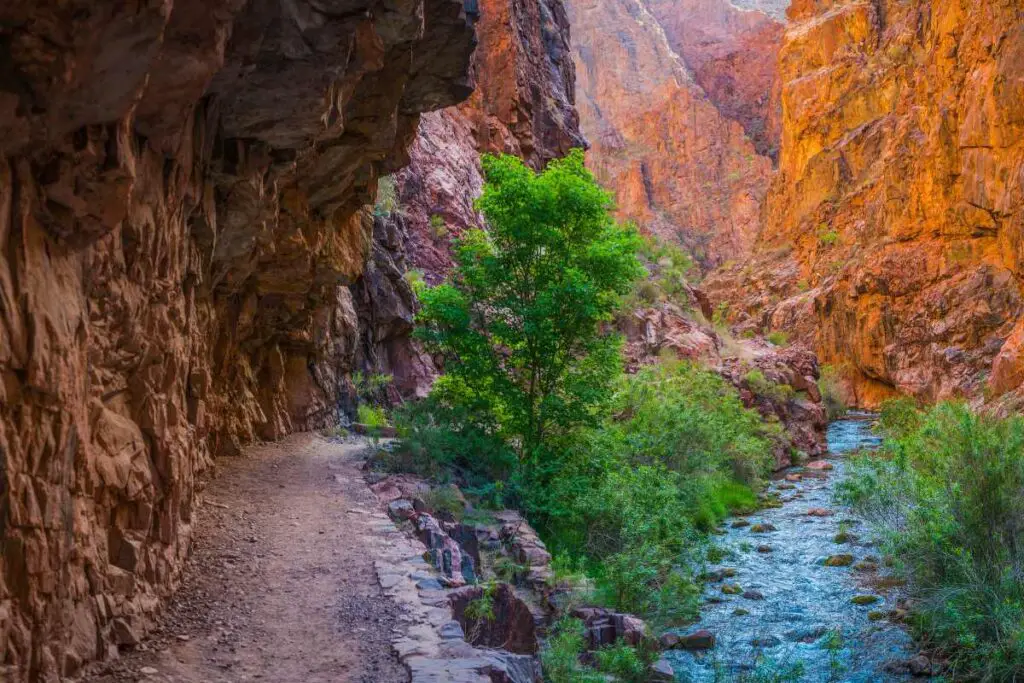
Hikers will pass through a variety of landscapes, including forests, meadows, and rocky cliffs. One of the highlights of the North Kaibab Trail is passing through “The Box,” a narrow canyon carved by Roaring Springs Creek.
Bright Angel Trail

The Bright Angel Trail is the most popular trail on the South Rim and is the easiest of the three corridor trails.
The trail is 9.5 miles long and descends 4,380 feet from the Bright Angel Trailhead to the Colorado River. The trail is well-maintained and offers stunning views of the canyon along the way.
The Bright Angel Trail is also the only trail that has water available year-round at several rest houses and the Colorado River. Hikers can refill their water bottles at Indian Garden and Bright Angel Campground.
South Kaibab Trail
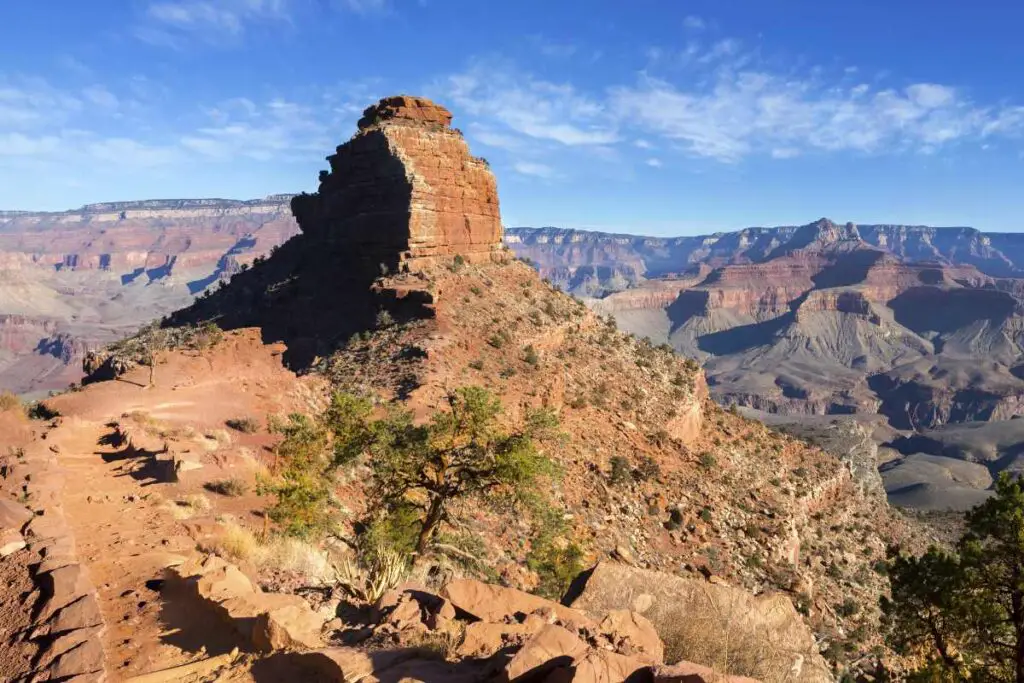
The South Kaibab Trail is the shortest and steepest of the three corridor trails.
The trail is 7.1 miles long and descends 4,780 feet from the South Kaibab Trailhead to the Colorado River. The trail offers stunning views of the canyon and is well-maintained.
One of the highlights of the South Kaibab Trail is the Kaibab Suspension Bridge, which crosses the Colorado River. Hikers will also pass by several landmarks, including Ooh-Aah Point, Cedar Ridge, and Skeleton Point.
Overall, all three corridor trails offer unique and stunning views of the Grand Canyon.
Hikers should be prepared for steep descents and ascents, as well as extreme temperatures. It is recommended to bring plenty of water, snacks, and sunscreen.
Accommodations and Campgrounds
When planning a Rim to Rim hike, it is essential to have a clear idea of where you will be staying overnight.
There are several campgrounds and lodges available along the trail, each with its own unique features and amenities.
Below are some of the most popular options:
Phantom Ranch

Phantom Ranch is a rustic lodge located at the bottom of the Grand Canyon. It is one of the most exclusive lodges in America and offers a unique experience for hikers.
The lodge has both dormitory-style and cabin accommodations, and reservations are required well in advance.
The lodge also has a canteen that serves breakfast and dinner, making it an ideal option for hikers who do not want to carry their own food.
Cottonwood Camp
Cottonwood Camp is a popular campground located about 7 miles from the North Rim. It is an excellent option for hikers who want to break up their hike into smaller segments.
The campground has a water source and restrooms, but hikers must bring their own food and camping gear. Reservations are required, and the campground can fill up quickly, especially during peak hiking season.
Indian Garden
Indian Garden is a beautiful campground located about halfway between the North and South Rims.
The campground has a water source, restrooms, and a ranger station, making it an ideal option for hikers who want to take a break and rest.
Reservations are required, and the campground can fill up quickly during peak hiking season.
Bright Angel Campground
Bright Angel Campground is a popular campground located at the bottom of the Grand Canyon.
It is an ideal option for hikers who want to spend a night at the bottom of the canyon before starting their ascent.
The campground has a water source, restrooms, and a ranger station. Reservations are required, and the campground can fill up quickly, especially during peak hiking season.
When planning your Rim to Rim hike, it is essential to research and book your accommodations well in advance.
Whether you choose to stay at a lodge or a campground, make sure to bring all the necessary gear and supplies to ensure a comfortable and enjoyable hiking experience.
Essential Gear and Supplies
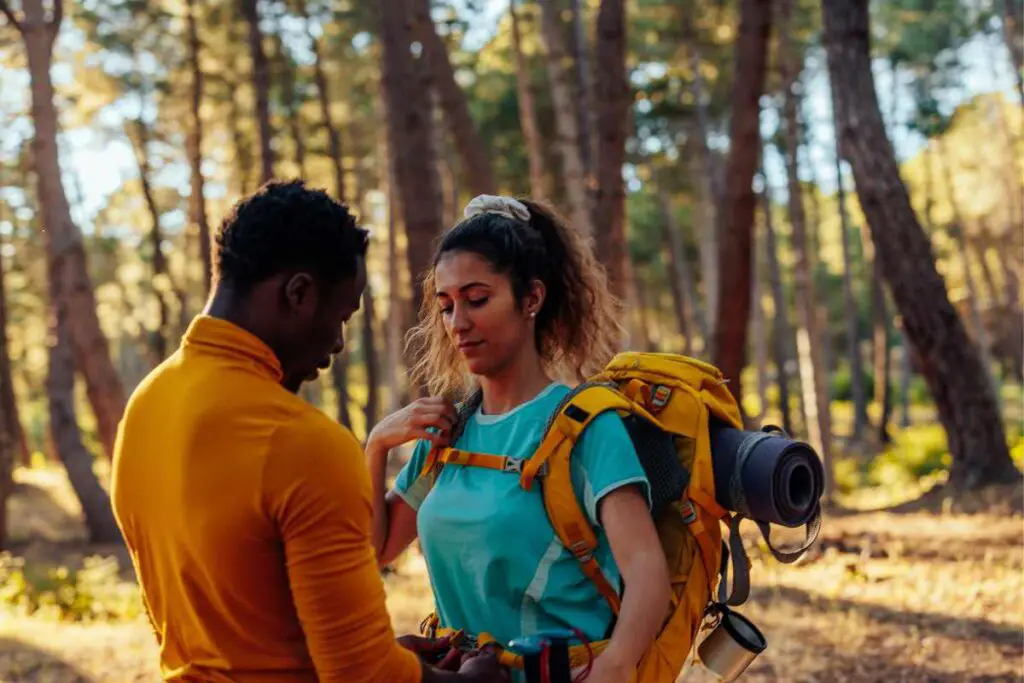
If you’re planning to hike the Grand Canyon Rim-to-Rim, you need to make sure you have the right gear and supplies to make the trip as safe and enjoyable as possible.
Here are some essential items to consider:
Hydration System
One of the most crucial things to consider when preparing for a Grand Canyon hike is hydration.
You will need to carry a lot of water with you, and it’s important to have a hydration system that works for you.
A hydration system can be a water bottle, hydration bladder, or a combination of both.
Make sure you have enough carrying capacity to last the entire hike, and consider bringing a water filter or purification tablets in case you need to refill along the way.
Hiking Boots
Your hiking boots are one of the most important pieces of gear for a Grand Canyon hike. You need to make sure they are comfortable, provide good support, and have good traction.
It’s also important to break them in before the hike to prevent blisters and other foot injuries. Consider visiting a store like REI to get fitted for the right pair of boots.
Used Gear
If you’re on a budget, consider buying used gear for your Grand Canyon hike. You can find used gear at outdoor gear stores, online marketplaces, and even garage sales.
Just make sure the gear is in good condition and fits well before you buy it. Buying used gear can save you money and help reduce waste by giving gear a second life.
Preparation and Training

Physical Training
Preparing for a Rim to Rim Grand Canyon hike requires physical training. Hiking the Grand Canyon is a strenuous activity that requires endurance and strength.
You need to be in good physical shape to complete the hike. A training program that includes cardio exercises, strength training, and hiking is recommended.
Cardio exercises such as running, cycling, and swimming can help improve your endurance.
Read next – Is hiking good cardio?
Strength training exercises such as squats, lunges, and deadlifts can help build your leg muscles. Hiking on hills or stairs can help simulate the terrain of the Grand Canyon and prepare you for the hike.
It is important to gradually increase the intensity and duration of your training to avoid injury. A 12-week training program that includes a mix of cardio, strength training, and hiking is recommended.
Mental Preparation
Mental preparation is also important for a Rim to Rim Grand Canyon hike.
The hike can be physically and mentally challenging, and it is important to be mentally prepared for the hike.
Visualizing the hike and setting goals can help you mentally prepare for the hike. It is also important to have a positive attitude and be mentally resilient.
The hike can be physically and mentally challenging, but with the right mindset, you can overcome any obstacles.
It is also important to be prepared for the unexpected. The weather can change quickly, and you may encounter unexpected obstacles on the trail.
Being mentally prepared for these challenges can help you stay focused and motivated during the hike.
In summary, physical and mental preparation are both important for a successful Rim to Rim Grand Canyon hike.
A training program that includes cardio, strength training, and hiking can help prepare you physically for the hike. Visualizing the hike, setting goals, and having a positive attitude can help you mentally prepare for the hike.
Read next – How to Train for Hiking Without Hiking
Safety and Considerations

When planning a Rim-to-Rim hike of the Grand Canyon, it’s essential to prioritize safety.
The unforgiving desert climate of the Canyon makes hiking it physically demanding and challenging.
Here are some important safety considerations to keep in mind before embarking on this adventure.
Weather and Temperature
The weather and temperature in the Grand Canyon can be extreme and unpredictable.
The temperature at the bottom of the canyon can be up to 20 degrees warmer than at the rim, so it’s vital to check the weather forecast before starting the hike.
Also read – Winter hiking mistakes you can avoid
In the summer, temperatures can soar over 100°F, while in the winter, temperatures can drop below freezing. Hikers should carry plenty of water, wear sunscreen, and dress appropriately for the weather conditions.
Read next – Grand Canyon Winter Hiking
Elevation Gain and Loss
The Rim-to-Rim hike involves a significant elevation gain and loss, which can be physically demanding.
The North Kaibab Trail descends 5,761 feet from the North Rim to the Colorado River, while the Bright Angel Trail ascends 4,380 feet from the Colorado River to the South Rim.
Hikers should be prepared for the elevation changes and take their time to acclimate to the altitude.
Leave No Trace
The Grand Canyon is a fragile and unique ecosystem, and it’s essential to leave no trace when hiking Rim-to-Rim.
Hikers should pack out all their trash, avoid disturbing wildlife, and stay on designated trails.
It’s essential to follow the seven principles of Leave No Trace, which include planning ahead, traveling and camping on durable surfaces, disposing of waste properly, leaving what you find, minimizing campfire impact, respecting wildlife, and being considerate of other visitors.
In addition to these safety considerations, hikers should also be aware of any warnings or alerts issued by the National Park Service.
It’s crucial to stay informed and prepared for any changes in weather or trail conditions. By taking the necessary precautions and being prepared, hikers can have a safe and memorable Rim-to-Rim hike in the Grand Canyon.
Natural Features and Landmarks
The Grand Canyon is one of the most iconic natural wonders in the United States, known for its vast and unique landscape.
The canyon is home to a variety of natural features and landmarks that make it a must-visit destination for hikers and nature enthusiasts alike.
Colorado River

The Colorado River is the primary feature of the Grand Canyon, flowing through the bottom of the canyon and carving out the rock formations over millions of years.
The river is a popular spot for rafting and kayaking, and many hikers will take a dip in the river to cool off during their rim-to-rim hike.
Roaring Springs

Roaring Springs is a beautiful oasis in the middle of the Grand Canyon, providing a refreshing break for hikers during their journey.
The spring is located near the North Kaibab Trail and is fed by underground water sources, creating a stunning waterfall that cascades down the canyon walls.
The Tipoff Overlook
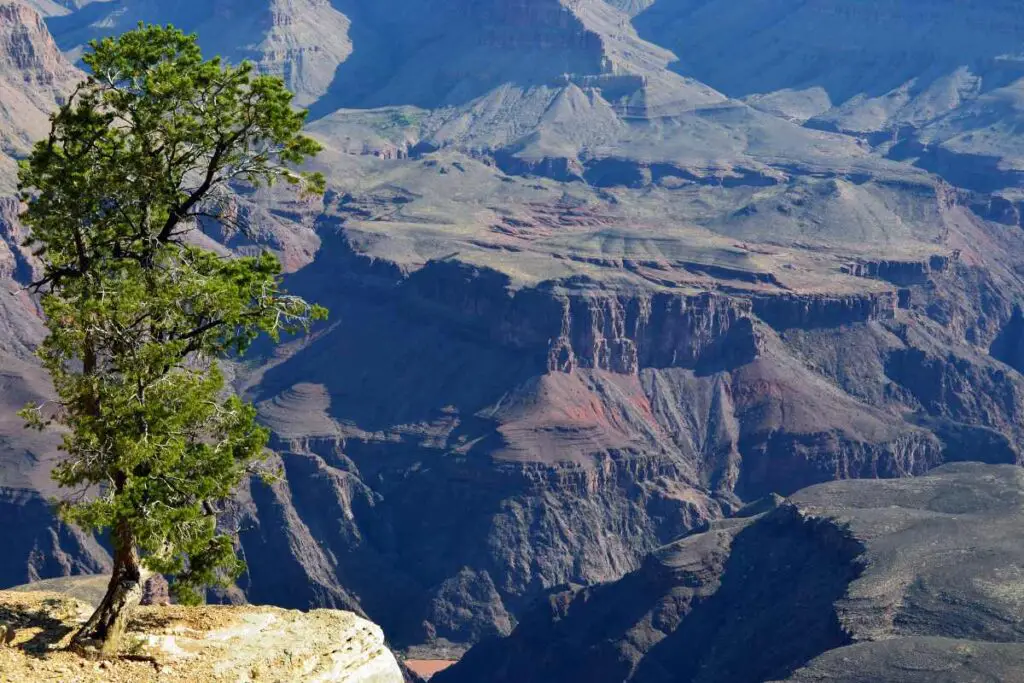
The Tipoff Overlook is a popular spot for hikers to take in the breathtaking views of the Grand Canyon.
Located on the South Kaibab Trail, the overlook offers panoramic views of the canyon and is a great spot to rest and refuel before continuing on the hike.
Cape Final

Cape Final is a stunning overlook located on the North Rim of the Grand Canyon, offering incredible views of the canyon and surrounding landscape.
The overlook is accessible via a short hike from the Cape Final Trailhead and is a great spot to watch the sunset.
Cape Royal
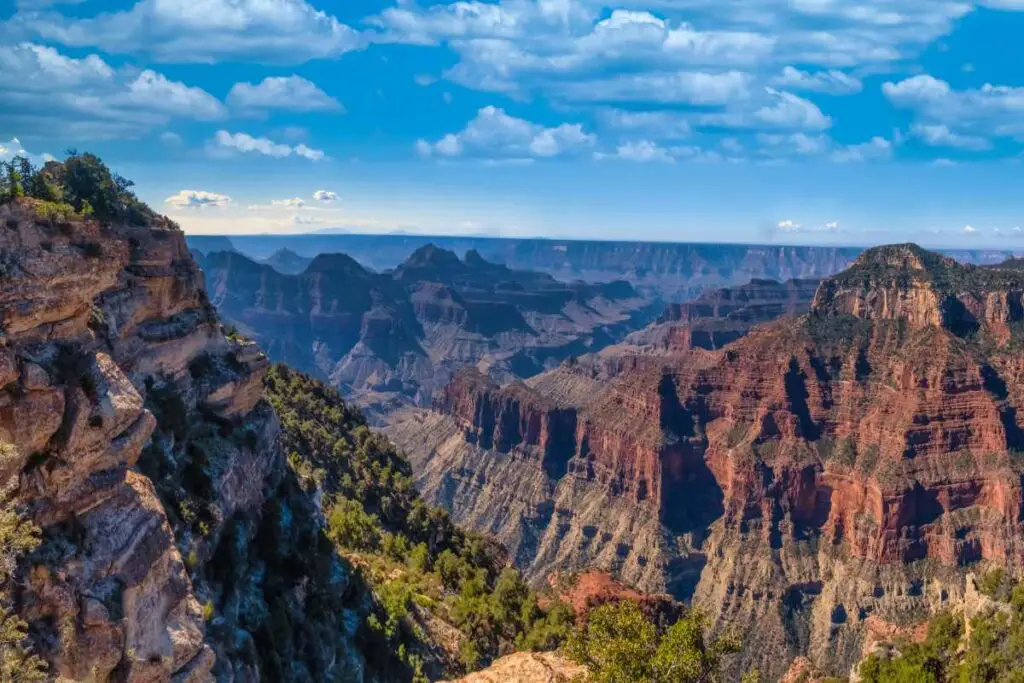
Cape Royal is another popular overlook on the North Rim of the Grand Canyon, offering stunning views of the canyon and Colorado River below.
The overlook is accessible via a short hike from the Cape Royal Trailhead and is a great spot to watch the sunrise.
The Grand Canyon is home to a variety of natural features and landmarks that make it a unique and unforgettable destination.
From the Colorado River to Roaring Springs and the Tipoff Overlook to Cape Final and Cape Royal, there are countless opportunities for hikers to take in the stunning beauty of the canyon and create memories that will last a lifetime.
Frequently Asked Questions
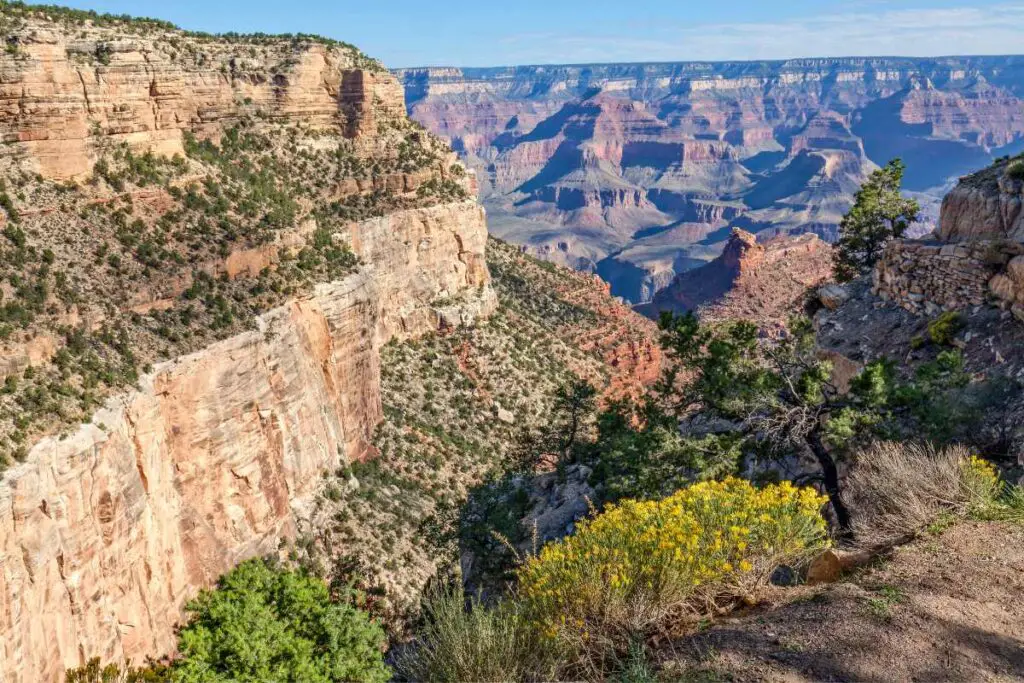
What are the best trails for hiking the Grand Canyon’s rim to rim?
The South Kaibab Trail and the Bright Angel Trail are the two most popular trails for hiking the Grand Canyon’s rim to rim. Both trails are challenging and offer stunning views of the canyon. The South Kaibab Trail is steeper and more exposed, while the Bright Angel Trail is longer but has more shade and water sources.
How long does it typically take to hike the Grand Canyon rim to rim?
Hiking the Grand Canyon rim to rim typically takes two to three days as a backpacking trip. As a day hike, it can take anywhere from 12 to 18 hours depending on your fitness level and experience. It is important to plan ahead and be prepared for the physical and mental demands of the hike.
What is the best time of year to hike the Grand Canyon rim to rim?
The best time of year to hike the Grand Canyon rim to rim is in the spring (March to May) or fall (September to November) when temperatures are cooler and crowds are smaller. Summer months can be extremely hot and crowded, while winter months can be snowy and icy, making the trails more dangerous.
Is it possible to hike the Grand Canyon rim to rim in one day?
It is possible to hike the Grand Canyon rim to rim in one day, but it is not recommended for most hikers. The hike is extremely strenuous and requires a high level of fitness and experience. Only experienced hikers with proper gear and preparation should attempt a one-day hike.
What are the difficulty levels of hiking the Grand Canyon rim to rim?
Hiking the Grand Canyon rim to rim is considered an extremely strenuous hike with a high level of difficulty. The trail involves steep inclines and declines, high elevation changes, and exposure to extreme weather conditions. Hikers should be in excellent physical condition and have prior hiking experience before attempting the hike.
Do I need a permit to hike the Grand Canyon rim to rim?
A permit is not required for a day hike of the Grand Canyon rim to rim, but it is required for overnight backpacking trips. Permits can be obtained through the National Park Service in advance or through a lottery system for popular camping areas like Phantom Ranch. It is important to plan ahead and obtain the necessary permits for your trip.
